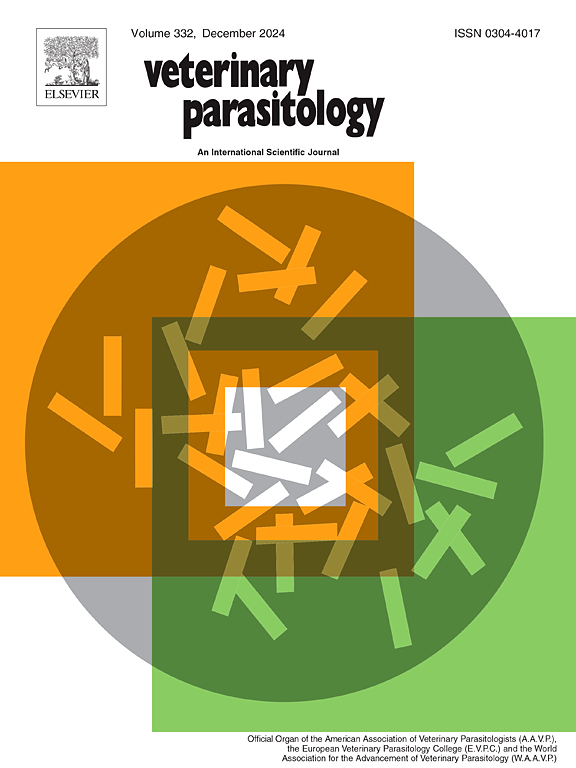出现囊异孢子虫和其他肠道寄生虫的狗和猫腹泻
IF 2.2
2区 农林科学
Q2 PARASITOLOGY
引用次数: 0
摘要
对患有腹泻的幼犬(117例)和猫(118例)中囊异孢子虫和其他肠道寄生虫的发生情况进行了评估。粪便样本采用浮选和蔗糖浓度处理,并对每只动物进行粪便和临床评分。评估球虫和/或其他肠道寄生虫的发生与临床症状严重程度之间的统计学关联。仅感染犬类囊异孢子虫7只(6.8 %),仅感染俄亥俄猪类囊异孢子虫3只(3.4 %),同时感染犬类囊异孢子虫1只(0.9 %)。40只猫(33.9 %)球虫检测呈阳性,其中33只猫(28 %)仅携带猫囊异孢子虫,6只猫(5.1 %)仅携带里氏囊异孢子虫,1只猫(0.8 %)同时携带两种球虫。其他记录的寄生虫有贾第鞭毛虫、钩虫科、弓形虫科和带绦虫科。所有球虫病犬的粪便都非常柔软。分别有4/21(19 %)和2/5(40 %)的猫感染猫绒球菌和利伏塔绒球菌后出现水样/出血性腹泻。猫中球虫和弓形虫、钩虫和贾第虫的发生率显著高于狗(p ≤ 0.05),反之亦然。在狗身上发现的其他显著关联是:犬链球菌活性和阳性降低,粪便非常柔软,弓形虫科阳性。在猫中,钩虫科阳性与呕吐、脱水、水样/出血性腹泻显著相关。本研究强调了囊异孢子虫在患有腹泻的年轻狗和猫中经常发生,猫的发病率高于狗。临床评分结果表明,C. canis和C. rivolta分别在狗和猫中具有更强的致病作用。本文章由计算机程序翻译,如有差异,请以英文原文为准。
Occurrence of Cystoisospora spp. and other intestinal parasites in dogs and cats with diarrhea
The occurrence of Cystoisospora spp. and other intestinal parasites in young dogs (n. 117) and cats (n. 118) with diarrhea was evaluated. Fecal samples were processed using flotation and sucrose concentration, and fecal and clinical scores were assigned to each animal. Statistical associations between the occurrence of coccidia and/or other intestinal parasites and the severity of clinical signs were evaluated. Seven dogs were infected only with Cystoisospora canis (6.8 %), 3 only with Cystoisospora ohioensis-like (3.4 %) and 1 with both (0.9 %). Forty cats (33.9 %) tested positive for coccidia, i.e. 33 (28 %) only with Cystoisospora felis, 6 (5.1 %) only with Cystoisospora rivolta, and 1 (0.8 %) with both. Other parasites recorded were Giardia spp., Ancylostomatidae, Toxocara spp. and Taeniidae. All dogs with coccidiosis had very soft feces. Watery/hemorrhagic diarrhea was detected in 4/21 (19 %) and 2/5 (40 %) cats infected with C. felis and C. rivolta, respectively. The occurrence of coccidia and Toxocara, and of hookworms and Giardia, was significantly higher (p ≤ 0.05) in cats than in dogs, and vice versa. Other significant associations found in dogs were: reduced activity and positivity to C. canis, presence of very soft feces and positivity to Ancylostomatidae. In cats, the positivity to Ancylostomatidae was significantly correlated with vomiting, dehydration, watery/hemorrhagic diarrhea. This study highlights the frequent occurrence of Cystoisospora spp. in young dogs and cats with diarrhea, with a higher incidence in cats compared to dogs. The clinical score results suggested a more pathogenic role of C. canis and C. rivolta in dogs and cats, respectively.
求助全文
通过发布文献求助,成功后即可免费获取论文全文。
去求助
来源期刊

Veterinary parasitology
农林科学-寄生虫学
CiteScore
5.30
自引率
7.70%
发文量
126
审稿时长
36 days
期刊介绍:
The journal Veterinary Parasitology has an open access mirror journal,Veterinary Parasitology: X, sharing the same aims and scope, editorial team, submission system and rigorous peer review.
This journal is concerned with those aspects of helminthology, protozoology and entomology which are of interest to animal health investigators, veterinary practitioners and others with a special interest in parasitology. Papers of the highest quality dealing with all aspects of disease prevention, pathology, treatment, epidemiology, and control of parasites in all domesticated animals, fall within the scope of the journal. Papers of geographically limited (local) interest which are not of interest to an international audience will not be accepted. Authors who submit papers based on local data will need to indicate why their paper is relevant to a broader readership.
Parasitological studies on laboratory animals fall within the scope of the journal only if they provide a reasonably close model of a disease of domestic animals. Additionally the journal will consider papers relating to wildlife species where they may act as disease reservoirs to domestic animals, or as a zoonotic reservoir. Case studies considered to be unique or of specific interest to the journal, will also be considered on occasions at the Editors'' discretion. Papers dealing exclusively with the taxonomy of parasites do not fall within the scope of the journal.
 求助内容:
求助内容: 应助结果提醒方式:
应助结果提醒方式:


